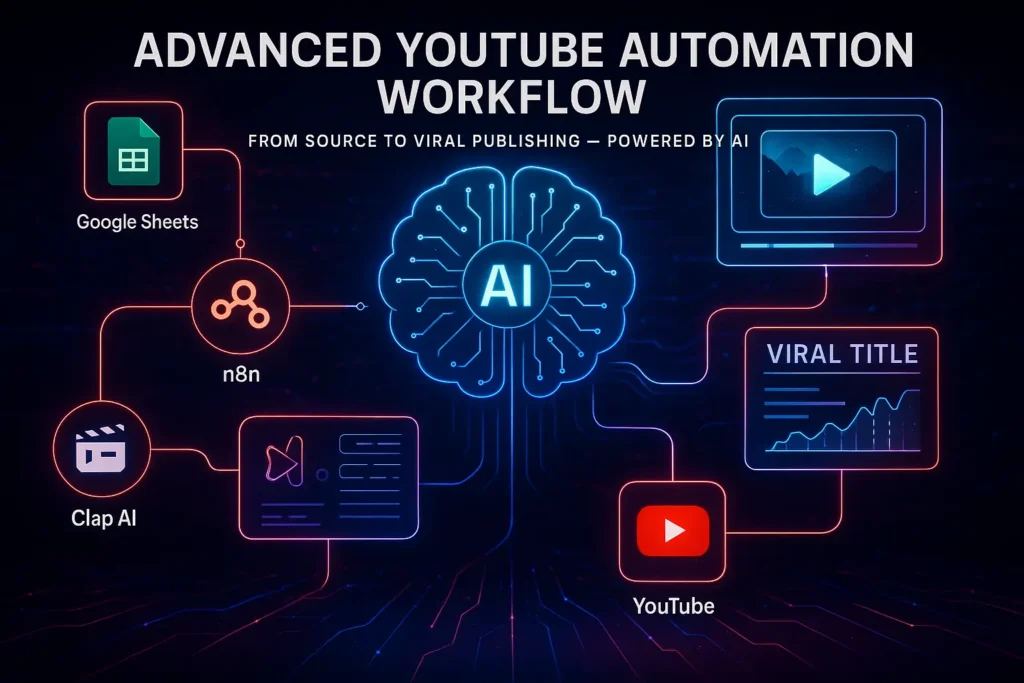We’re living in a revolution where Artificial Intelligence is evolving from a simple tool to an autonomous team member. But what does that evolution actually look like?
The difference between simply chatting with an AI and having an AI run an entire business process is massive. Here, we break down the three levels of AI automation—from basic Q&A to fully self-directed agents—and show you how we’re using an advanced AI workflow to scale our YouTube content creation.
Level 1: Ai Automation Regular Neural Networks (LLMs)
This is the AI everyone knows — the smart chatbot powered by AI automation, like ChatGPT.
What it is: A large language model (LLM) that works on a simple input → output process. You type a question, and it instantly generates an answer — a classic example of early AI automation in action.
The Limitation: These systems are passive and isolated. They wait for instructions and don’t take action on their own. Without integration, they can’t access your external or personal data — like Google Calendar or your YouTube channel. So, while they’re smart and helpful, they’re still tools — not true automated agents.

Level 2: AI Workflows – Automation with Logic
At this stage of AI automation, you move beyond simple chatting and start automating real tasks by creating structured sequences of actions.
What it is: An AI workflow is a logical chain of steps powered by AI automation — for example, if A happens, then do B and C. It’s all about control logic: you decide what to do and when to do it.
How it works: You connect the LLM with other services, like your calendar or email, and define the automation route. The AI then follows this sequence exactly — like, “If I ask about events, check my Google Calendar first.”
The Limitation: This level of AI automation still lacks flexibility. If you don’t explicitly tell it to “check the weather,” it won’t — even if it’s the next logical step. As long as you manually design the route, it’s a process, not a self-adapting agent.
Level 3: AI Agents & Advanced Automation
This is where the magic happens. A true AI Agent is more than just execution—it can think, act, and adapt.
The Core Difference: Agents vs. Workflows
| Feature | AI Workflow (Level 2) | AI Agent (Level 3) |
|---|---|---|
| Logic | Strict Script: Follows a pre-set, fixed sequence of steps. | Reasoning & Iteration: Chooses how to solve the task and adjusts its path. |
| Action | Passive: Executes steps only when commanded in sequence. | Autonomous: Operates tools and launches actions without waiting for a command. |
| Adaptation | None: If the result is bad, a human must manually change the script and rerun it. | Refines: If the first solution doesn’t work, it tries again, often using the ReAct (Reason + Act) logic. |
Our Advanced YouTube Automation Workflow
We built a powerful AI automation system that bridges Level 2 and Level 3 automation using platforms like n8n (similar to Make or Zapier) to minimize human effort.
Source: The workflow automatically pulls new long-form video links from a Google Sheet — the first step in the AI automation pipeline.
Clip Generation: Each video is sent to Clap AI (or a similar tool) to automatically create multiple vertical shorts, detecting emotional peaks for maximum impact.
Viral Content Generation: Using ChatGPT-driven AI automation, the content of each short is analyzed with a custom prompt to produce viral titles and descriptions optimized for YouTube Shorts growth.
Publishing: Finally, the workflow completes the loop — fully automating the upload and publishing process to YouTube, including titles, descriptions, and tags — all handled by AI automation.
The Agentic Goal
While our workflow is highly automated, the ultimate goal is a true AI Agent that can:
- Reason: Instead of just grabbing the latest video, it would analyze the channel’s metadata, audience behavior, and trending topics to choose which video is most likely to go viral.
- Iterate & Refine: It could send its generated title to a second LLM (playing the role of a YouTube editor) for feedback (“This title is too generic”) and then create a new, better version on its own.
- Test: In the future, it might even test ad concepts on an “AI audience” before launching the final content.

Your Call to Action: Start Simple
Whether you’re an entrepreneur or just looking to improve your productivity, the first step is to inspire yourself to automate.
Don’t start by building a complex agent. Start simple:
- Identify one repetitive task you always do by hand.
- Ask: “What can I automate in my workflow?”
By automating just one process, you begin the journey toward building your own AI agent, allowing you and your team to focus on creative, high-impact tasks.




